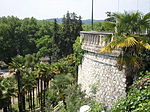Béarn (US: ; French: [beaʁn]; Occitan: Bearn [beˈaɾ] or Biarn; Basque: Bearno or Biarno; Latin: Benearnia or Bearnia) is one of the traditional provinces of France, located in the Pyrenees mountains and in the plain at their feet, in Southwestern France. Along with the three Basque provinces of Soule, Lower Navarre and Labourd, the Principality of Bidache, as well as small parts of Gascony, it forms the current Pyrénées-Atlantiques department. The capitals of Béarn were successively Beneharnum (until 841), Morlaàs (from c. 1100), Orthez (from the second half of the 13th century) and then Pau (beginning in the mid-15th century).Béarn is bordered by the Basque provinces of Soule and Lower Navarre to the west, Gascony (Landes and Armagnac) to the north, Bigorre to the east, in addition to Spain (Aragon) to the south.
Today, the mainstays of the Béarn area are the petroleum industry, the aerospace industry through the helicopter turboshaft engine manufacturer Turbomeca, tourism and agriculture (much of which involves maize (corn) grown for seed). Pau was the birthplace of Elf Aquitaine, which has now become a part of the Total S.A. petroleum company.
In Alexandre Dumas's The Three Musketeers series, the protagonist d'Artagnan came from Béarn; he mentions having attended his father's funeral there in the second book, Twenty Years After. In the first book of the series, upon meeting the Cardinal, it is also noted that d'Artagnan comes from Béarn. That d'Artagnan is usually referred to as a Gascon is neither surprising nor incorrect, as Béarn forms part of Gascony.
In the eastern part of the province are two small exclaves belonging to Bigorre. They are the result of how early Béarn grew to its traditional boundaries: some old lesser viscounties were added by marriage, and absorbed into Béarn: Oloron to the south/southwest ca. 1050, Montanérès in the east in 1085, and Dax in the west in 1194. When Montanérès was added, five communities or parishes (Villenave-près-Béarn, Escaunets, Séron, Gardères, and Luquet) did not form part of the dowry; they remained, or became, part of Bigorre. Their attachment to Bigorre continues to the present, as they followed it into Hautes-Pyrénées, rather than being incorporated into the surrounding Pyrénées-Atlantiques.









